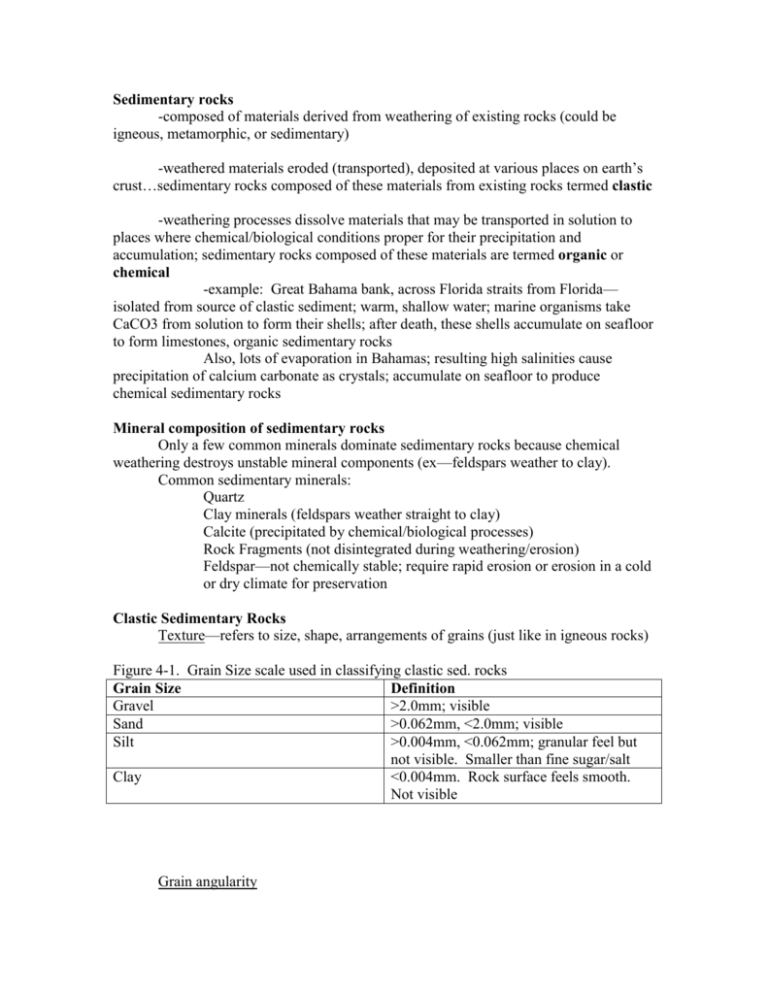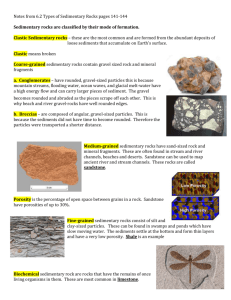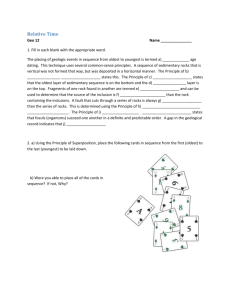Sedimentary rocks
advertisement

Sedimentary rocks -composed of materials derived from weathering of existing rocks (could be igneous, metamorphic, or sedimentary) -weathered materials eroded (transported), deposited at various places on earth’s crust…sedimentary rocks composed of these materials from existing rocks termed clastic -weathering processes dissolve materials that may be transported in solution to places where chemical/biological conditions proper for their precipitation and accumulation; sedimentary rocks composed of these materials are termed organic or chemical -example: Great Bahama bank, across Florida straits from Florida— isolated from source of clastic sediment; warm, shallow water; marine organisms take CaCO3 from solution to form their shells; after death, these shells accumulate on seafloor to form limestones, organic sedimentary rocks Also, lots of evaporation in Bahamas; resulting high salinities cause precipitation of calcium carbonate as crystals; accumulate on seafloor to produce chemical sedimentary rocks Mineral composition of sedimentary rocks Only a few common minerals dominate sedimentary rocks because chemical weathering destroys unstable mineral components (ex—feldspars weather to clay). Common sedimentary minerals: Quartz Clay minerals (feldspars weather straight to clay) Calcite (precipitated by chemical/biological processes) Rock Fragments (not disintegrated during weathering/erosion) Feldspar—not chemically stable; require rapid erosion or erosion in a cold or dry climate for preservation Clastic Sedimentary Rocks Texture—refers to size, shape, arrangements of grains (just like in igneous rocks) Figure 4-1. Grain Size scale used in classifying clastic sed. rocks Grain Size Definition Gravel >2.0mm; visible Sand >0.062mm, <2.0mm; visible Silt >0.004mm, <0.062mm; granular feel but not visible. Smaller than fine sugar/salt Clay <0.004mm. Rock surface feels smooth. Not visible Grain angularity Grains angular when eroded from source area; during transport become Rounded; degree of angularity indicates distance of transport Ex.—coarse grained clastic rocks—conglomerate (rounded) vs. Breccia (angular). Grain sorting Measure of how equal in size the grains are: Poorly sorted—varied grain sizes throughout Well sorted—same grain size throughout Ex—beaches w/ wave action—well sorted (due to fines being removed, coarse left behind) vs. glaciers—poorly sorted (glaciers transport all sizes) Not important in identification of sed rocks but provides clues to physical conditions of deposition Figure 4.2—Identification of clastic sedimentary rocks Grain Size Composition and Shape Coarse: >2.0mm Rounded/angular grains of qtz, feldspar, chert Medium: 0.062-2.0 mm Quartz grains/feldspar grains Fine: 0.004-0.062mm Too fine for identification; probably qtz Very fine: 0.004mm Too fine for identification; Probably clay minerals Rock Name Conglomerate/breccia Qtz sandstone/arkosic sstone Siltstone Shale Organic and Chemical Rocks -sedimentary rocks formed by biologic activity or by direct precipitation from sea water Types: Limestone Fossiliferous limestone (organic rock)—composed of calcite; may contain fossils, skeletal fragments of marine organisms. Chalk (organic rock)—composed of microscopic skeletons of tiny organisms; have white, smooth surfaces due to size of fossils Oolitic limestone (chemical rock)—smooth, spherical grains of calcite— sand size. Oolites form due to high energy environment, being rolled back and forth by wave action. Micrite (chemical rock)— composed of microscopic calcite crystals. Smooth surface as a result Dolomite Some of calcium replaced with magnesium—probably from groundwater Chert Composed of microscopic qtz crystals. Some biologic from organisms that use silica for shells; also can be chemical (groundwater replacement), with the silica source being volcanic ash (ex—Boone limestone cherts) Coal Composed of carbon from plant remains that have been buried and compressed. Individual plants have lost their form from the compression. From low to high grade, depending on pressure and temperatures of formation: LigniteBituminousAnthracite Bauxite Formed from clay minerals. In humid, tropical conditions, silica removed from clays forming an aluminum-rich soil (oxisol or laterite); with loss of water, this may harden and form bauxite. This is refined to produce aluminum. Syenite in Central Arkansas sufficiently weathered 35-50 million years ago to produce bauxite. How? Syenite high in feldspars (aluminum-rich); feldspars weather straight to clay; aluminumrich clays dry to become bauxite. Identification and classification of organic and chemical rocks—Figure 4.3 Composition Characteristics Rock Name Calcite Visible fossil fragments Fossiliferous Limestone Calcite Visible ooliths Oolitic Limestone Calcite Microscopic fossils; white; Chalk chalky surface Calcite Microcrystalline; gray, Micrite brown, black in color Dolomite Microcrystalline; feeble Dolostone acid reaction Quartz Microcrystalline; very hard Chert Carbon Black; blocky; will mark Bituminous Coal paper Clay minerals Red; soft, with pisoliths Bauxite Halite Light to medium gray; salty Rock Salt taste Depositional Environments Before they were rocks, sediments accumulated at specific places under specific conditions in the geologic past. Characteristics of sed rocks, plus knowledge of how modern sediments accumulate provide clues about conditions that existed where the sediment was deposited. Beaches, eolian dunes, organic reefs all characterized by specific physical, chemical, biological conditions; each is a depositional environment. Each environment imparts characteristics that can be recognized in a rock long after the environment is gone. Geologists interested in reconstruction of past depositional environments. Importance? Example—Ancient reefs and river channels have permeabilities that allow circulation of petroleum, uranium-bearing fluids Coarser grained rocks—higher energy environments; finer grained rocks—lower energy environments; organic rocks—protected environments (ex-limestones only in clear, shallow, warm water (none in gulf of mexico!)) Clastic depositional environments Alluvial fans—at foot of mtn ranges in arid climates. Streams carry sediments from mts but lower elevation deserts unable to maintain flow to carry sediment, so it gets deposited at the mountain front. Sediment poorly sorted; may contain unstable Feldspars due to short transport time. Ex.—Sangre de Cristo mts, southern CO, Death Valley, CA Eolian dunes—composed of wind-blown sand. Well-sorted, rounded grains; example—great sand dunes nat’l park, Sangre de Cristo mts, southern CO Alluvial sediments—deposited in channel or on floodplain during floods. Moderately well sorted in channels (gravel and sand); Flood plain sediment poorly sorted, composed of silt and clay. Ex—white river flood plain/Mississippi river delta, eastern Arkansas Marshes—low, swampy areas on coastal plains nr. Sea; occur on alluvial flood plains and on emergent deltas. Sediment accumulates very slowly; vegetation grows well; perfect place for accumulation of plant remains which eventually become coal. Ex—E Arkansas, in Mississippi embayment Delta—masses of sediment deposited by rivers at their mouth. Form seaward, characterized by several depositional environments. Sand accumulates on seaward edge and in distributary channels; clay, silt deposited atop as delta builds seaward—ex., Mississippi delta. Builds birds-foot seaward because of dredging by corps of engineers Lagoons—bodies of water between barrier islands and mainland—protected by islands from waves/turbulence; clay and silt deposition; no plant remains Barrier Islands—deposited down current from deltas—sand well sorted by wave activity Shelf—moderately shallow sea floor, extends seaward from mainland to edge of continental slope. Fine grained sediments deposited here due to quiet water not affected by current activity. Non-clastic depositional environments Oolith shoals—shallow, turbulent water; occur in narrow shoals around margin of shallow shelves Skeletal sand shoals—slightly deeper water than oolith shoals. Organic reefs—form at margin of shallow shelves where there are nutrients from open sea for organisms. Reef builders have strong shells to withstand waves that attack shelf margins Lagoons—between barrier reefs and shallower parts of shelf, or part of shelf interior. Protected from turbulence. Often produce micrites; because of lack of energy, fine particles accumulate Open Sea—Deep ocean not favorable for carbonates—carbonate not stable at depth; chert can accumulate, though...because silica stable below carbonate compensation depth Uses of sedimentary rocks Limestone—crushed stone for “gravel,” concrete aggregate Sandstone—building stone Bituminous coal—source of energy Bauxite—ore of aluminum








